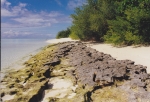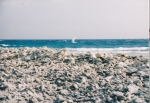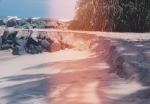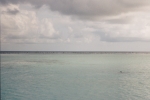Water Waves, Their Properties And Coast-recovery
Abstract Category: Engineering
Course / Degree: master of science
Institution / University: Private, United Kingdom
Published in: 2014
Water waves transfer mechanical energy. In waters there are three kinds of mechanical energy transfer. The first is a spherical voluminous energy transfer called the longitudinal wave transfer. The second is the transversal energy transfer. The third, is corpuscular-kinetic energy transfer that resembles water waves but are water currents or flows mixed with transversal and longitudinal waves of secondary and reflected origin.
The longitudinal waves come from the depths of water basins. Mostly, they come from the sea bed and underwater slopes. The second, the transversal, the predominant waves in the waters, are caused mainly by winds. And to lesser extents are converted longitudinal waves that reach the upper surface of the waters. Among which are the most dangerous ones, the Tsunamis. Both the waves originate also as secondary waves when they get reflected at ends.
The third, corpuscular-kinetic currents and wave-like-flows are formed when the previous two reach shallow waters. They are the flows and currents mixed with secondary waves at the beaches coasts and.
Longitudinal water-waves and their effects
The mechanical waves that travel in voluminous mediums are longitudinal waves. They are, like transversal, harmless as long as they remain longitudinal. They can become harmful in the seas, as soon as they turn into corpuscular-kinetic currents and wave-like-flows. But when nature is left to have its own course then they are, mostly useful. Save when they are triggered to become Tsunamis (also useful?).
Longitudinal in contrast to others originate at the depths and at underwater slopes. Earthquakes and tremors, instantaneous shrinkage blasts in the sediments, Underwater landslides and volcanic effusions trigger the most amount of longitudinal waves. A small amount come from reflected and falling waves and in minor scale by the havocs of submarine predators and thunders.
Longitudinal waves spread energy spherically outwards from the place of origin. The energy is transferred from a molecule to another molecule from the place of origin. The giver molecule comes back to its original position oscillatingly, after passing the energy to the neighbouring molecule. The receiver molecule spreads the wave-energy further. Since the energy transfer is in spheres from the place of origin, the amount of receiver molecules increase as the energy spreads outwards. As a result energy held per molecule decreases with distance. And the wave becomes mild.
The water basins are not endless. The longitudinal waves reach walls, slopes and the upper surface of the waters. If they reach a underwater wall then they get reflected and continue to be longitudinal waves in the reflected direction. When they reach upper surface of water they turn into transversal waves. When the forces are high in the longitudinal waves they turn not only into transversal waves when they reach the upper surface but also into corpuscular-kinetic waves which may have speeds going at 500 km/h (Origin of tsunamis).
The longitudinal waves when they come to a slope, they get reflected upwards. As the waves rise the amount of water decreases then they turn into corpuscular-kinetic currents or wave-like flows along the slope upwards. As they climb they accumulate energy in the molecules and throw water upwards making rolling waves which dash towards the Coast mainly as corpuscular-kinetic currents and mixture of other waves.
Wave-throw as sea-bed becomes shallower
At the distance the water is calm and have no corpuscular-kinetic transfer of energy. There the waves are transversal and remain harmless. As the transversal reaches shallow waters they get thrown up and turn into corpuscular-kinetic currents or wave like water flows. They have mixed waves coming from different directions. ---The region, at present, is erosive. But when the slope of the sea-bed is increased the corpuscular-kinetic currents will become productive.
Harms of longitudinal water waves
Longitudinal waves are not harmful when they remain as longitudinal waves. But in the water basin they cannot remain continually as longitudinal waves. Sooner or later, either directly or through transversal waves, they have to end up as corpuscular-kinetic currents. Then they may become harmful to the coasts when the slope is low. If the slope of the sea bed is steep they are useful to the coasts. Namely, they bring marine fossils and floral drops to the coasts.
Longitudinal waves that come from the bottoms after Earth quakes are very strong. They turn to corpuscular-kinetic when they reach the slopes. The other part which reach straight the upper surface, turn into transversal. They may come almost near to the Coast appearing to be transversal, but in reality corpuscular-kinetic energy transfer. They throw up as a big rolling wave and dash into the land. They are very dangerous. They may have speeds reaching 500 kmph. These waves are harmful to humans. But in nature the answer is relative, mostly useful.
Advantages of longitudinal water waves
Longitudinal water waves that climb up the slopes are very useful. As they rise they change into corpuscular-kinetic flow. They push fossils and floral rests up in waves. Many calcareous marine lives are found in near-depths and also on the slopes of the seas. Their remnants which have pores and cavities are relatively light, though they are of lime with specific gravity 2.5 or near about. They idle on beds and slopes till waves come.
As the waves slide up they bring the fossils up to form land-bars and reefs at the stretch where the rising waves throw themselves up. The land-bars and reefs as they come above water level offer area for vegetations to set root. Bars and reefs are normally some tens of meters off the Coast. Since they form at such distances, they provide a good protective shield for the main land. As time passes they become islands with much fertility that the protection is consolidated with the spreding of botany.
In many parts of the world the bars and reefs have just disappeared and are not forming.The reasons are very diverse. Whatever, the main retarder is the depletion of coastal botany. As soon as the matter is mended, the important usage of bars/reefs, forming by rising longitudinal waves will take effect.
Formation of bar/reef Bar near the wave throw stretch
Transversal water waves
Most of the water waves are transversal. Mostly they are formed by winds that drag the water surface. Secondly they are converted longitudinal waves. And in lesser amount are reflected waves.
They are, like longitudinal, harmless. They too transfer energy from one molecule to another, shoulder to shoulder or arm to arm or belly to belly. The giver molecules after transferring the energy to the next get back to their original positions the way they do in longitudinal waves. But the waves themselves travel further. As they travel they come to shallows. In the shallows the amount of water molecules available to carry energy lessens. But the momentum remains almost the same. As such the momentum of individual molecules increases. Then they turn into corpuscular-kinetic currents or wave-like-flows.
In all three cases of energy transfer, the sea-bed on which the waves and currents travel decides the fate of the wave or current. When the sea bed turns shallower the currents and flows begin. When they reach depths transversal and longitudinal waves prevail.
There is an interesting phenomenon at work when the transversal waves are formed by high winds. Namely, a type of Bernoulli effect appears. When the transversal wave traverses in high winds, in front of it a wave comes up before the traversing wave reaches its position. It is due to the pressure drop caused at the wind shade. Water rises before the wave and brings the travelling transversal wave down behind it. And the process continues as long as the wind is strong.
Corpuscular-kinetic current or wave-like-flow of water
They are called waves, despite they are dashing currents and flows at the coasts, because of their frequency, amplitude and other properties of waves. These are converted longitudinal or transversal waves. Corpuscular-kinetic energy-transfer originate when other waves reach shallow waters. Which means: as other waves reach shallow waters the amount of molecules available to transfer the energy are less. The momentum must have its course. The receiver molecules, which are less now, having almost the same physical properties, balance the momentum by turning to move. The water gets thrown and form corpuscular-kinetic currents of water. Yet, longitudinal as well as transversal waves, in much lesser degree from the initial, as well as secondary waves mix up in the current confusing the whole flow from deciphering what is what.
They turn aggressive and become unpredictable. They are a mixture of many movements. They have water currents whirling to and fro and dangerous currents dashing sea wards. They have minor transversal and longitudinal waves criss-crossing and throwing themselves up. They are relentlessly rolling and cancelling as well as enhancing one another. They do the damages to the Coast and either spoil the fun of holiday makers or make it interesting for them. Whatsoever, if well manoeuvred, the aggressive property of the waves can be turned to work in favour of the Coast and beaches.
Harms done by corpuscular-kinetic-waves
The main harm is coastal erosion. They drive the soil hither and thither and mill them. As the soil are milled and made minute they get carried into the depths. As the soil reach depths the slope decreases. This in turn makes the longitudinal and transversal waves to leap longer distances towards the Coast. And they have a self catalysing effect. Milling and eroding Dashing waves breaking walls
Advantages of corpuscular-kinetic wave-like-currents
Corpuscular-kinetic wave-like-currents are integral part of the Coast. They are needed to the Coast. And from all three, the aggressive corpuscular-kinetic currents, under natural conditions, make the Coast to grow. They are Coast growers. They make atoll islands to come above water by heaping marine remnants of corals, sea shells, marine botany and other biology from the sea beds.
Under natural conditions, one can always see that the waves have washed much marine weeds ashore. They cover the Coast like a carpet. The carpets of weeds protect the soil from being washed by rains and blown away by winds. The weeds get settled and mix up with the soil and improve its quality.
Besides, coastal currents together with winds spread seeds along the Coast and bring them elsewhere. And in addition, corpuscular-kinetic flows help the Coast to be clean. They wash relentlessly as they come and go.
How are corpuscular-kinetic currents or wave-like-flows formed.
(Since corpuscular-kinetic-currents resemble waves, for the sake of convenience, they could be called as corpuscular-kinetic-waves)
Mostly they are born as the transversal and longitudinal waves throw themselves up in a long stretch as they climb the slopes of the sea bed. As they climb the amount of molecules needed to share the momentum decreases. The remaining molecules get a rise in their individual momentums and start moving upwards. As they come near the surface along the slope the speed increases. There are no receiver molecules at the surface in the direction of the rising waves. The waves throw themselves up. Then they fall in an angle and dash towards the Coast.
The wave-throw stretch is generally called as wave break stretch. But appropriate term is the stretch of wave-throw. Because the phenomenon is similar to a knock-wave coming along a line of arranged balls having equal physical properties in a smooth grove, or railway compartments on a line. Every ball passes the momentum to the next and remain in place. The last ball having no receiver next to it throws itself out and sets itself in motion.The same is with railway compartments. That is the same physical process when waves appear to leap some tens of metres away from the Coast. It is not a leap it is a wave-throw. After the wave-throw, the thrown water is mainly corpuscular-kinetic currents or wave-like-flows.
The formed currents are mixed with secondary longitudinal and transversal waves. The resulting flows are dynamic turbulence, and one cannot follow which comes from where. One can only observe the frightening dash towards the Coast.
Important properties of water waves.
1. Water waves can convert themselves into one another depending on the amount of water available. A longitudinal wave can turn into transversal wave or corpuscular-kinetic current. And vice-versa.
2. They are important ingredient of the Coast.
3. When they are bounced back at natural or artificial conditions, the bounced waves increase the erosion from under as well as from over.
4. The water waves are stronger as they come towards the Coast and weaker when they return. Which means: if they wash ashore a big object, there are very high chances that they leave the object and go. If not the waves dangle the object along the Coast. Old saying: The wrecked ship was washed ashore. Gulliver was found sleeping deeply washed ashore. Robinson Crusoe made a life because the wrecked ship was washed ashore.
5. When the Coast is depleted of its natural botany, the waves rising at rough times can reduce the height of the Coast within hours. Natural soil with botany-cover has a high percentage of humus and fine material. The fine material and humus being so light they just get washed away. The height of the soil just drops: The Beginning of coastal erosion!!
6. The water waves could be split and tranquillised. There force or momentum could be reduced gradually. It could be reduced with horizontal planes, vertical planes, in pillar forms as well as with suspended and floating weights.
7. Water waves always leap-roll towards the Coast. The returning waves flow back in currents. Also when an island is small having just some hundred meters of diameter, the waves leap-roll towards the Coast, all around the island. The waves coming from the weather side (wind side) embraces the circular Coast. The same wave coming to the lee-side disperses (bends) and throws itself towards the Coast.
8. Mostly the water waves meet the Coast at a small angle. This makes the soil in the Coast to be driven hither and thither. Forming tongues which could be made peninsulars or small islands. In islands the waves heap soil on the lee-side in the water. Giving an opportunity to increase the land area. If promptly acted!!! Else, as the wind changes they take the heap around milling and diluting it in the waters.
Soils have been deposited on the lee-side. Potential new islands and lands neglected
Waves clash in an angle and drive the soil away to deposit them on the lee-side.
9. Water waves when tranquillised make sea bed biology to flourish. Which again makes the Coast to grow. In the pictures above and under the land surface is just exposed to erosion. The soil that get eroded reduces the slope of the sea bed. That makes the corpuscular-kinetic currents to become aggressive.
Botany depleted and slope has decreased and erosion gallops up
The slope is becoming lesser. Though the depth could be seen. After the next rain, erosion will gallop forwards.
10. Water waves under natural conditions, make the sea bed slope at Coast steeper. But when the Coast is depleted of natural botany cover, the waves pull down fine sand and decrease the slope. This action catalyses the aggression of the waves.
11. And many more.
If one loves the waves, if not respects, if that´s not possible, fears and treats with dread. Things become easier. Try tender treatment like the intercity express driver, after touching 400 kph and more, brings the train to the station. Smoothly, softly and noiselessly.
Paper Keywords/Search Tags:
coastal recovery
This Paper Abstract may be cited as follows:
No user preference. Please use the standard reference methodology.
Submission Details: Paper Abstract submitted by Balasupramaniam Paramahamsa from United Kingdom on 05-Sep-2014 19:55.
Abstract has been viewed 3088 times (since 7 Mar 2010).
Balasupramaniam Paramahamsa Contact Details: Email: eecoltd2@gmail.com
Disclaimer
Great care has been taken to ensure that this information is correct, however ThesisAbstracts.com cannot accept responsibility for the contents of this Paper abstract titled "Water Waves, Their Properties And Coast-recovery". This abstract has been submitted by Balasupramaniam Paramahamsa on 05-Sep-2014 19:55. You may report a problem using the contact form.
© Copyright 2003 - 2025 of ThesisAbstracts.com and respective owners.



